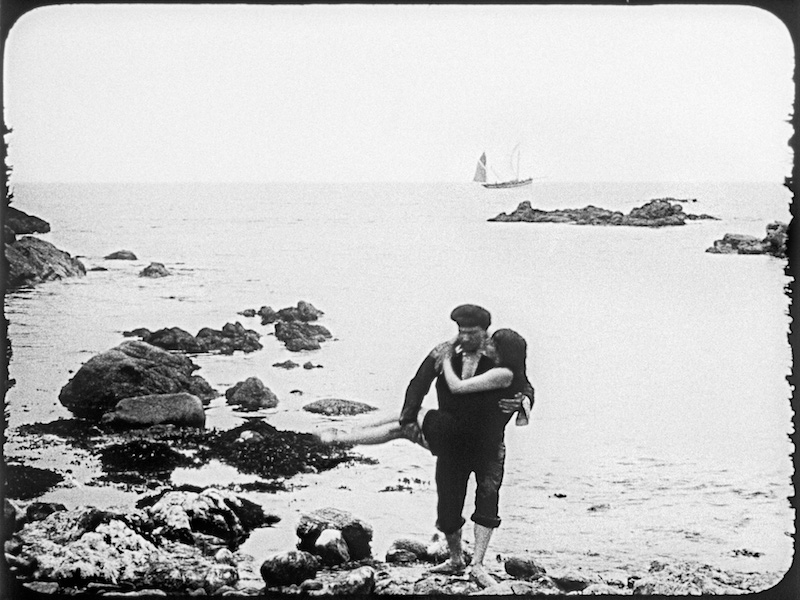LA GLU
Albert Capellani (FR 1913)
Albert Capellani adapted his scenario from a colorful best-selling 1881 roman-feuilleton and 1883 stage play of the same title, both by Jean Richepin, a prolific poet, novelist, and playwright. La Glu was first performed by Réjane, the great French comic actress of the late 19th century, who – like Mistinguett a generation later – incarnated the fun and spontaneity of the Parisienne on the stage. The narrative of La Glu, focusing on an unrepentant femme fatale, was hardly original: as contemporary audiences acknowledged, it nodded to Honoré de Balzac’s Béatrix, Émile Zola’s Nana, Émile Augier’s Mariage d’Olympe, and Alphonse Daudet’s L’Arlésienne, using the vulgar language of Richepin’s Chanson des gueux.
Fernande, the daughter of a professor in Douai in northern France, lures Doctor Cézambre into marriage after he ministers to her sick father, and soon takes up with a lover. Eventually she leaves Cézambre for Paris, where she enjoys the attention of many admirers, especially a young Breton aristocrat, Adelphe des Ribiers, whom she brushes off when his disapproving grandfather writes that he will cut off his money. She decides to rent a villa in Brittany, where she bewitches a fisherman, Marie-Pierre, whose increasing passion his mother and fiancée cannot control. La Glu quickly tires of this new conquest and goes away for several days, and the dazed sailor returns home. Fate brings Cézambre, Adelphe and his grandfather, Marie-Pierre, and Fernande all to the same place, the village café in Le Croisic, and soon there is a confrontation in La Glu’s villa. Stunned by La Glu’s shameless revelations of her serial infidelity, Marie-Pierre staggers around the room and accidentally injures himself, and is taken to his mother’s house, where Doctor Cézambre comes to dress his wounds; and Fernande struts in for the climactic denouement. Just as the original play provided satiric fodder for Réjane to perform Sarah Bernhardt’s famous attacks of nerves in moments of dramatic tension, so too does the film, which treats this melodramatic story of rural France with satire and irony, most obviously just before all the main characters finally converge, heralded by the intertitle, “Dramatique coïncidence…”, a wild understatement.
The word branding Fernande, “La Glu,” is a scurrilous bit of slang for an immoral femme fatale, a seductive siren who captivates and victimizes all manner of men. With her bright eyes, wide mouth, long legs, and limber body, Mistinguett is a perfect choice for the role. By turns vivacious, mischievous, impudent, and flaunting her allure, she commands the screen. The role allows her to wear eye-catching costumes, including a black one-piece bathing suit in the style of Annette Kellerman. The plot also gives her the chance, in front of her Parisian admirers, to put her skills as a dancer on full display. Tellingly, it is at the Paris open-air café-restaurant Le Pré Catelan that Mistinguett performs the Maxixe, a spirited Brazilian one-step/polka popular at the time in Paris and made famous by Vernon and Irene Castle in the USA – whereas the Castles’ version is elegantly graceful, Mistinguett throws her back-kicks with the verve of the music hall. Mesmerizing audiences then and now, this is just one example in the film where the versatile actress keeps slipping out from under the character’s misanthropic mask to perform herself in a Parisian revue act.
Capellani shot much of La Glu on location in the novel’s Brittany setting: the fishing village of Le Croisic, a nearby villa, and Guérande. This often gives exterior scenes a striking sense of deep space — in the garden of the doctor’s villa, where Fernande lounges in a hammock in the foreground; on the cobbled streets of Le Croisic, where Cézambre meets his friend, Adelphe’s grandfather; and on the rocky coast, where Marie-Pierre spies on Fernande and rescues her when she pretends to be drowning. The long-take interior scenes early on seem rather conventional, but very selective lighting enhances dramatic moments in several scenes, as when Cézambre discovers a series of love letters to his wife, and later, when Fernande, restrained by Marie-Pierre, yells back from her darkened villa bedroom at his mother, who is outside cursing them.
Discussions of Richepin’s play described La Glu as modern because it replaced choreographed passion with representations of pure instinct: La Glu’s lovers are not amorous clients but obsessed men from all walks of life (worker, professional, aristocrat; young and old). Yet La Glu manages to step outside the cocotte, reminding us of Mistinguett’s established skills and fame. Dying was possibly not one of them: a review in Le Journal at the time tells us that Mistinguett startled her fellow actors in the final scene by collapsing under the blows Marie-Pierre’s mother aimed at La Glu.
We would like to thank Catherine Surowiec for identifying the dance performed by Mistinguett in this film.
Richard Abel, Victoria Duckett


regia/dir: Albert Capellani.
scen: Albert Capellani, dal romanzo e dalla pièce di/based on the novel and play by Jean Richepin (1881; 1883).
photog: Karérime Mérobian, Louis Forestier.
cast: Mistinguett (Fernande, detta/called “La Glu”), Paul Capellani (Marie-Pierre), Henry Krauss (dottor/Doctor Pierre Cézambre), Marc Gérard (il vecchio Gillioury/Old Gillioury), Gina Barbieri (Marie des Anges, madre di Marie-Pierre/Marie-Pierre’s mother), Cécile Guyon (Anaïk, fidanzata di Marie-Pierre/Marie-Pierre’s fiancée), Henri Collen, Raoul Praxy.
prod: S.C.A.G.L.
uscita/rel: 07.11.1913.
copia/copy: 35mm, 1951 m., 95′ (18 fps), col. (imbibito/tinted); did./titles: FRA.
fonte/source: Cinémathèque française.
Preservato nel 2001 dalla Cinémathèque française a partire da un elemento di conservazione creato nel 1987 a partire dal negativo camera nitrato originale depositato dalla Fondation Seydoux-Pathé. /
Preserved 2001 by the Cinémathèque française from a conservation element created in 1987 from the original camera negative deposited by the Fondation Seydoux-Pathé




